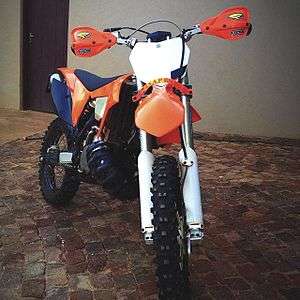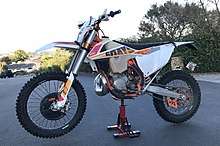KTM 300
The KTM 300 is a series of 2-stroke enduro off-road motorcycles made by KTM. They are the Penton-inspired 1984 300 GS, the 300 DMX, the dirt only 300 MXC, European road legal 300 EXC and their current US counterpart the 300 XC (close-ratio) and 300 XC-W (wide-ratio gear box) respectively. The KTM 300 is designed for difficult off-road conditions. The 300 EXC and the 300 XC-W have a small headlight, speedometer, tail-light and somewhat softer linkless PDS[note 1] suspension. Starting in 2008 all 300's came with electric start. Since the early 2000s KTM has been offering the XC-W model in a special "Six-Days" limited edition.
 | |
| Manufacturer | KTM-Sportmotorcycle AG |
|---|---|
| Also called | KTM 300 XC, KTM 300 XC-W |
| Predecessor | KTM 300 GS |
| Class | Enduro |
| Engine | Single-cylinder, liquid-cooled, Reed intake, Fuel injected, 2-stroke |
| Bore / stroke | 72 mm / 72 mm, 293 cc |
| Compression ratio | 13.2:1 |
| Top speed | 120 mi/h[1] |
| Power | 51 hp (38 kW) |
| Ignition type | Kokusan contactless, electronic, digital ignition timing adjustment |
| Transmission | 5 or 6-speed, wet clutch, chain drive |
| Frame type | Central double-cradle-type 25CrMo4 steel |
| Suspension | Front: WP USD 48mm; fully adjustable Rear: WP single shock; fully adjustable |
| Brakes | Hydraulic single disc
Front :260mm (10.24") Rear: 220mm (8.66") |
| Tires | 90/90-21"; 140/80-18" |
| Rake, trail | 26.5°, 4.4 in (110 mm) |
| Wheelbase | 58.35 in (1,482 mm) |
| Seat height | 37.8 to 38.8 in (960 to 990 mm) |
| Weight | 221.0 to 225.1 lb (100.2 to 102.1 kg) (dry) |
| Fuel capacity | 2.64–3.04 US gal (10.0–11.5 l; 2.20–2.53 imp gal) |
| Oil capacity | 0.7 liters / 0.74 qt. |
| Related | KTM 200 EXC, KTM 250 EXC, Husaberg/Husqvarna TE 300 |
Model progression
1984–1989
The original 300GS Enduro grew out of the experience with 250 cc Penton Hare Scrambler and other KTM air cooled 2-stroke enduro bikes. Since the 1986 rules for the International Six Days Enduro (ISDE) for the open class allowed any bike larger that 250 cc, KTM experimented with a water cooled over-250 cc bike for the open class. They essentially bored their 250 out to 273 cc and called it a 300. This version of the 300 was discontinued in 1987. KTM also tried sleeving down their 500mxc two-stroke to 350 cc calling it the 350mxc, but the left side kick-starter and the right side chain were not popular.[2][3]
1990–1997
In 1990 KTM got serious and the present-day 300 was born.[2] Dubbed the 300 EX/C, its engine delivered very smooth power and did not produce a power hit. The bike performed well at low RPMs. In the mid-range and the top-end the smooth power delivery allowed the rider control over a wide variety of riding conditions from tight trails to wide open stretches. The plush suspension worked well compared to the older GS models.[4]
The bike was also offered as the 300 DMX, a California desert version. These early KTM motors had 297 cc displacement with 72 mm x 73 mm bore/stroke. Still the 300 hadn't reached its full potential. Ignition and jetting problems plagued these early models. In 1992 the company suffered financial woes and development was slowed.[2] The 1993 KTMs had Öhlins USD[note 2] forks. WP forks were also used that year. In 1993 Motoplat went out of business, forcing KTM to switch to SEM ignition systems.[5] The 1996 model had Marzocchi USD forks and an Öhlins rear shock absorber, a chrome exhaust pipe and silencer, a motor with better performance, increased cooling and stock Boyesen reeds. For 1996–97 the bike was offered in a 360 cc version. In 1997 KTM switched to Kokusan ignition systems.[2]
1998–2003
1996 was the first year for the KTM trademark orange bikes. In addition to larger capacity radiators, the 300 received KTM’s PDS link-less rear suspension with 320 mm of rear wheel travel. The bike was again offered in a bored out 380 cc during 1998-2000 (a street legal title was offered in some states). In 1999 the 300 received a hydraulic clutch and the 2000 motor benefited from a redesigned cylinder.
2004–2007
In 2004 there was another frame change. There were significant engine changes, including a bore and stroke change and the carburetor size reduced from 38 mm to 36 mm, resulting in an 8 lb (3.6 kg) weight savings and no more jetting problems.[2] For 2006, the US version of the 300 EXC was replaced by the XC and the XC-W. Both versions had 5-speed gearboxes and a stator for producing electricity. The 300 XC had a close-ratio gear box, no wiring for lights, and a stiffer suspension. The 300 XC-W had a wide-ratio gear box, head light, tail light and maintained the softer PDS suspension. The 2007 model had added a dual ignition mapping switch on the handlebar.
2008–2016
The 2008 KTM 300 EXC is the first electric start two-stroke enduro bike to be released by a major manufacturer. All models have PDS rear suspension.
For 2010, Husaberg the other KTM owned bike company, offered the TE300, an XC-W with minor modifications to the bodywork and suspension settings.
In 2011, models received 6-speed gearboxes, a new exhaust pipe and silencer, and translucent fuel tanks. The XC was also upgraded to a new frame, while retaining PDS rear suspension. These frame updates did not make it to the XC-W until 2012. The 2011 Husaberg TE 300 was essentially a rebadged KTM 300 and was available through 2012.
In 2012 there were improvements to the starter motor bendix, more frame changes resulting in more wheel travel for models with PDS rear suspension (except the XC)[6], and a new air box with a filter that can be replaced without the use of tools. The 300XC was changed from PDS rear suspension to linkage rear suspension.[7] The 300XC-W models received the frame and bodywork updates that arrived in the XC line the year before, but also retain PDS rear suspension.
In 2013 the clutch was changed to a 'DDS' diaphragm spring clutch with lighter pull, a new stronger starter motor (350W motor was replaced with a 410W motor), lighter battery, and triple clamps changed from 22 mm to 20 mm offset. The Husaberg TE300 was rebranded the Husqvarna TE300 and also received linkage rear suspension.
In 2014 bikes received a new CDI unit and ignition curve, stronger/larger battery, changed jetting, updated brakes (front master cylinder, caliper, and pads changed), a redesigned cylinder head, new Boyesen reeds, stiffer seat foam, and a new rear shock absorber with revised settings.
The 2015 model chromoly steel frame is painted orange like the motocross models. All the 2015 models have the new WP 4CS forks with revised damping (rebound in one fork and compression in the other) with the ability to make adjustments on the fly, and a smaller front axle. The triple clamps have 2 mm less offset resulting in more trail and different steering characteristics. The rear shock is longer but the travel is unchanged. The electric starter has different gearing to provide higher initial torque from the electric motor, and the battery is lighter and stronger.[8][9][3]
2017– Present

The 2017 KTM 300's are completely redesigned bikes. A counter-balancer has been added to reduce motor vibration. The case is a new design featuring a new position for the starter motor. A Mikuni carb replaced the Keihin carburetor as Keihin focuses on fuel injection. There was a change to the air filter design. Suspension changed with the addition of a new Xplor 48 rear shock downsized from 50 mm to 46 mm. The forks are similar to the previous generation open cartridge forks supplied on the 300's with split compression and rebound adjusters. The adjuster atop the left fork controls compression and adjuster top the right fork controls rebound similar to the 4CS fork system.
For 2018 KTM started offering the 300 EXC (Europe only) model with transfer port injection (TPI) and with oil injection through the 39 mm Dell’Orto throttle body to meet EURO 4 standards.[10] [11]
For 2019 KTM began offering U.S. customers the 300 XC-W model with (TPI) and oil injection. The fuel injected 300's were previously available only in the international market. The KTM XC-W still comes with PDS rear suspension while the 300 XC and the Husqvarna TE (essentially a KTM with different plastics) come with linkage suspensions.
For the 2020 model year KTM began providing U.S. customers both the 300 XC-W and 300 XC with TPI and oil injection, thus eliminating all carbureted 300's from the US market. Both models benefit from updated EFI mapping and a new air pressure sensor. [12] The XC-W has been given an all new chassis derived from the SX models. Other minor changes include: An updated ECU, suspension settings and styling / plastic upgrades.[13]
For the 2021 model year the 300's feature only minor refinements from the previous models.[14]
Top speed 169
Notes
- PDS is an initialism for Progressive Damping System when referring to rear shock absorbers in non-linkage rear suspensions."
- USD is an initialism for UpSide Down when referring to telescopic forks on modern motorcycles."
References
- "2008 KTM 300 XC And XC-W (E)". TopSpeed. Retrieved 3 February 2016.
- "ALL ABOUT THE KTM 300 2-STROKE". Dirt Bike Magazine. Retrieved 9 February 2016.
- Scott Rousseau (19 June 2015). "2015 KTM Dual-Sport and Cross-Country Dirt Bikes". Off-Road.com. Retrieved 20 February 2016.
- "1990 KTM 300". Off-Road.com. Retrieved 20 February 2016.
- "motoplat systems and parts". Penton. Retrieved 11 February 2016.
- Dirt Bike "KTM Suspension Shootout: PDS vs. Lindage
- Dirt Bike "KTM Suspension Shootout: PDS vs. Lindage
- "KTM 300XC: ULTIMATE 2-STROKE OR ULTIMATE DIRT BIKE?". Dirt Bike Magazine. Retrieved 11 February 2016.
- "2016 KTM 300 XC-W Models First Looks". Moto USA. Retrieved 12 February 2016.
- Jimmy Lewis. "2018 KTM 250/300 EXC/XC-W TPI Riding Impression". Dirtbike Test. Retrieved 19 December 2017.
- "2018 KTM TWO-STROKES: BOTH EFI & CARBS". Dirt Bike. Retrieved 19 December 2017.
- Andrew Oldar (5 August 2019). "2020 KTM 300 XC TPI First Ride Review". Dirtbike Rider. Retrieved 25 November 2019.
- Staff. "2020 KTM 300XC-W Lean, Mean, Fighting Machine". Dirtbike Test. Retrieved 4 July 2020.
- Cycle News Staff (16 June 2020). "2021 KTM Off-Road XC-W XCF-W And EXC-F First Look". Cycle News. Retrieved 4 July 2020.